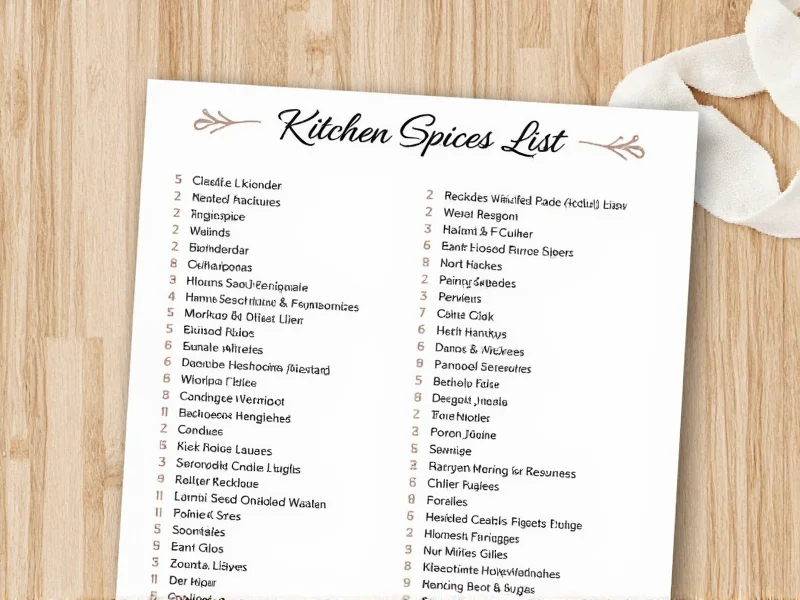Building Your Essential Spice Collection
Creating a well-stocked spice cabinet transforms ordinary meals into extraordinary culinary experiences. This kitchen spice list guide provides everything you need to build a versatile collection that covers most cooking needs. Whether you're a beginner cook establishing your first spice rack or an experienced chef looking to optimize your pantry, understanding which spices deliver maximum flavor impact is essential.
Why These 25 Spices?
After analyzing hundreds of recipes across global cuisines, these 25 spices consistently appear as foundational ingredients. They represent the perfect balance between versatility and specificity, allowing you to prepare dishes from multiple culinary traditions without overwhelming your pantry. A thoughtfully curated kitchen spice list saves both money and space while maximizing cooking flexibility.
Essential Kitchen Spice Categories
Understanding spice categories helps organize your collection and identify gaps. This comprehensive spice collection guide divides spices into four practical groups based on primary culinary applications.
| Category | Spices Included | Primary Culinary Uses |
|---|---|---|
| Foundation Spices | Salt, Black Pepper, Garlic Powder, Onion Powder | Base seasoning for virtually all savory dishes |
| Mediterranean Herbs | Oregano, Basil, Thyme, Rosemary, Parsley | Pasta sauces, roasted vegetables, grilled meats, salad dressings |
| Global Warm Spices | Cumin, Paprika, Chili Powder, Turmeric, Coriander | Curries, stews, chili, taco seasoning, rice dishes |
| Baking Spices | Cinnamon, Nutmeg, Ginger, Allspice, Cloves | Baked goods, desserts, warm beverages, some savory glazes |
Detailed Spice Profiles
Each spice on this kitchen spice list serves a specific purpose. Understanding their flavor profiles and best applications ensures you use them effectively in your cooking.
Must-Have Savory Spices
Cumin delivers earthy, warm notes essential for Mexican, Indian, and Middle Eastern cuisines. Use in chili, curry, and roasted vegetable dishes. Paprika ranges from sweet to smoked varieties, adding color and depth to stews, rubs, and deviled eggs. Coriander offers citrusy notes that balance rich meats and enhance vegetable dishes.
Essential Baking Spices
Cinnamon works beyond desserts—it enhances savory Moroccan tagines and adds warmth to breakfast dishes. Nutmeg should be used sparingly; freshly grated provides the best flavor for béchamel sauces, mashed potatoes, and baked goods. Ginger appears in both sweet and savory applications from gingerbread to stir-fries.
Proper Spice Storage Techniques
Learning how to store spices properly dramatically extends their shelf life and maintains flavor intensity. Most ground spices retain optimal flavor for 6-12 months, while whole spices last 1-2 years. Follow these storage guidelines:
| Storage Factor | Best Practice | Impact on Shelf Life |
|---|---|---|
| Container Type | Airtight glass or metal containers | Prevents moisture and air exposure |
| Light Exposure | Store in dark cabinet away from windows | Prevents flavor degradation from UV light |
| Temperature | Cool, stable environment (60-70°F) | Prevents accelerated flavor loss |
| Humidity | Avoid steamy areas like above stove | Prevents clumping and mold growth |
Spice Pairing Guide for Home Cooks
Understanding complementary spice combinations elevates your cooking. This kitchen spice list includes pairings that work across multiple cuisines:
- Italian Blend: Basil + Oregano + Rosemary + Garlic Powder
- Mexican Blend: Cumin + Chili Powder + Paprika + Cilantro
- Indian Curry Base: Turmeric + Coriander + Cumin + Ginger
- Baking Spice Mix: Cinnamon + Nutmeg + Allspice + Cloves
- Mediterranean Rub: Thyme + Rosemary + Garlic + Lemon Zest
Building Your Collection Strategically
When establishing your kitchen spice cabinet essentials, prioritize purchasing whole spices whenever possible and grind them as needed. Whole spices maintain flavor significantly longer than pre-ground versions. Start with the foundation spices (salt, pepper, garlic, and onion powder), then expand into one category at a time based on your cooking preferences. This approach to building a basic spice collection prevents waste and ensures you use each spice regularly.
Testing Spice Freshness
Check your spices' potency with these simple tests:
- Smell Test: Fresh spices have strong, distinctive aromas
- Color Check: Faded color indicates flavor loss
- Taste Test: Dull or musty flavor means it's time to replace
- Texture: Clumping suggests moisture exposure
Final Thoughts on Your Spice Journey
Building a comprehensive kitchen spice list transforms your cooking capabilities without requiring expensive specialty ingredients. Start with these essential spices, learn their flavor profiles, and gradually expand based on your culinary interests. Remember that proper storage and regular freshness testing ensure you always cook with maximum flavor impact. Whether you're preparing simple weeknight dinners or elaborate holiday feasts, this kitchen spice collection provides the foundation for delicious, well-seasoned meals.











 浙公网安备
33010002000092号
浙公网安备
33010002000092号 浙B2-20120091-4
浙B2-20120091-4